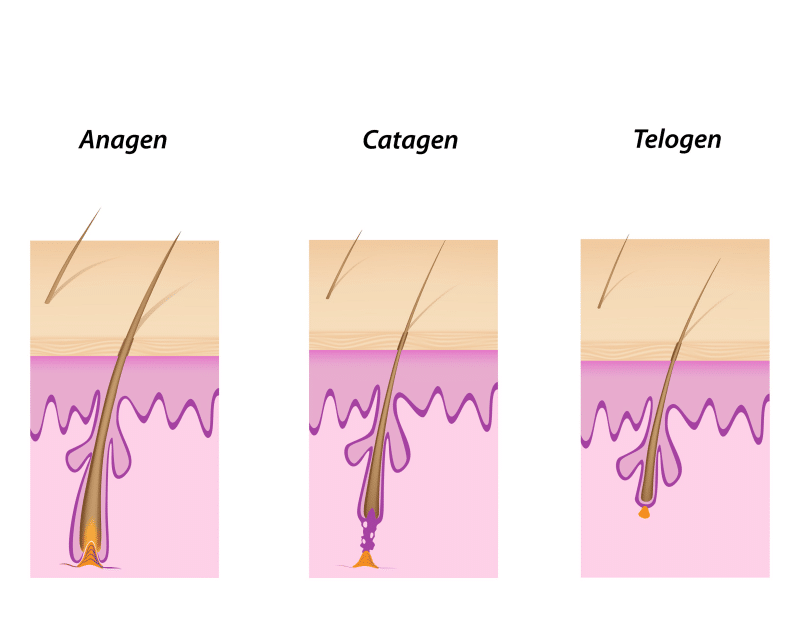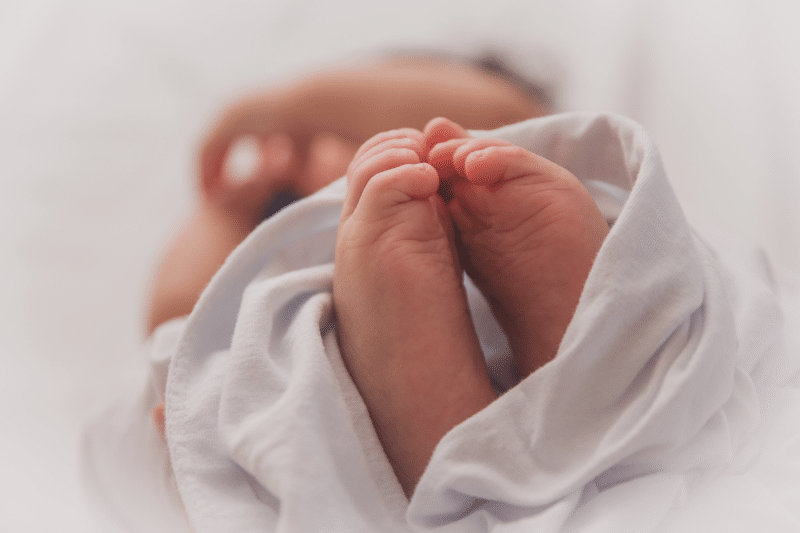Pregnancy is a time filled with dramatic physiological and psychological changes for a woman. Unfortunately these changes do not end once the pregnancy is over and continue well into the postpartum period. One such change is post-partum hair loss, a phenomenon that, although temporary, is significantly unnerving for new mothers already drained from taking care of their newborn.
Post-partum hair loss usually manifests itself within the first three months after giving birth, and in most cases spontaneously disappears after 6-12 months.
On average a healthy female loses around 80-100 strands of hair a day, however, this number increases to up to 400 per day postpartum. Previously breastfeeding was thought to be responsible for this sudden hair loss, however, recent studies have shown no significant relationship between the two.
Hair growth cycle
To understand the changes that occur in hair follicles postpartum, it is essential to first acknowledge how the hair growth cycle normally works, and therefore have a clear understanding of its three different phases:
 Anagen (or growth phase): Hair grows fairly rapidly. This phase lasts about 3-5 years.
Anagen (or growth phase): Hair grows fairly rapidly. This phase lasts about 3-5 years.
Catagen (or transition phase): Hair follicles detach from their nourishing blood supply. This phase lasts about 1-2 weeks.
Telogen (or resting phase): Hair strands fall out to give place to new anagen hair. This phase lasts for roughly 3 months.
Pregnancy and hair growth cycle
In the usual non-pregnant state, 85-95% of all hair is in the growth phase at the same time, however, during pregnancy this percentage increases due to the hormonal changes. This effect is secondary to increase blood volume, and circulation, as well as an increase in the estrogen levels that usually prevent hair loss. This explains why women observe thicker than usual hair during pregnancy.
This situation though changes dramatically right after giving birth, as the hormonal changes occur once again. This time, the number of hair in the telogen phase increases, causing immediate shedding of hair. This hair loss accounts for all the hair loss that should have occurred in the previous nine months but didn’t due to the elevated hormones. The shedding becomes apparent around 3 months postpartum and lasts around 6-12 months. After this period, hair loss usually goes back to what it was before pregnancy, if this does not happen then secondary causes, such as for example postpartum thyroiditis, should be looked into.
Studies on postpartum hair loss
Postpartum alopecia has been the subject of studies since the early ’90s, when the connection between fluctuating maternal hormones and hair loss was initially made. In a more recent study, published in 2013, 116 pregnant women were followed throughout their term and postpartum to observe the changes in the hair cycle. The ratios of anagen and telogen were measured using a Trichoscan before and after the term. It was statistically concluded, that the anagen ratio elevated during the pregnancy, whereas, the telogen rate rose post-partum in all participants. The researchers also studied the effect of breastfeeding in the subjects and found no significant hair loss difference between breastfeeding and non-breastfeeding females.
 Postpartum alopecia can also be explained with another phenomenon called telogen effluvium. This scalp disorder is characterized by the early entry of hair in the telogen phase. This alteration in the hair cycle is proposed to be a result of a specific trigger event, such as for example childbirth, eating disorders, chronic disease, major surgery, severe psychiatric disorders, as well as certain medications, etc. Telogen effluvium is estimated to affect around 40-50% of all postpartum females.
Postpartum alopecia can also be explained with another phenomenon called telogen effluvium. This scalp disorder is characterized by the early entry of hair in the telogen phase. This alteration in the hair cycle is proposed to be a result of a specific trigger event, such as for example childbirth, eating disorders, chronic disease, major surgery, severe psychiatric disorders, as well as certain medications, etc. Telogen effluvium is estimated to affect around 40-50% of all postpartum females.
Managing postpartum hair loss
Unfortunately, no single drug therapy has been found to reverse or prevent the occurrence of postpartum alopecia, and currently, management protocols only include education about hair cycles and reassurance to minimize anxiety.
Some recommendations to try to limit hair loss after pregnancy and try to return to a pre-pregnancy hair quicker, include:
– Dietary changes. Essential vitamin supplements and high protein, fresh fruits, and vegetables in the diet can help combat hair loss postpartum. The recommended nutrients by the American Pregnancy Association include Vitamin B complex, biotin (B7), Iron, Vitamin C, Vitamin E, and Zinc, etc.
– Regular gentle-moderate exercise. This can help to smoothen the physical transition of the body to its pre pregnancy state.
– Using gentle hair shampoo and conditioner formulas during this period can further lessen hair loss.
– Using a wide-toothed comb to ease detangling of hair without extra force and opting for looser hairstyles can also lessen traction on already weakened roots.
– Avoiding any chemical-based treatments such as concentrated dyes, highlights, perms, and straightening agents during this period.
– Gentle messaging of castor or almond oil can also stimulate healthy hair growth.
– Minimizing stress levels as much as possible. Increased stress levels elevate the cortisol, a steroid hormone that negatively impacts the hair cycle, further exacerbating the damage.
References:
Lynfield YL. Effect of pregnancy on the human hair cycle. Journal of Investigative Dermatology. 1960 Dec 1;35(6):323-7.
SCHIFF BL, KERN AB. Study of postpartum alopecia. Archives of dermatology. 1963 May 1;87(5):609-11.
Gjerdingen DK, Froberg DG, Chaloner KM, McGovern PM. Changes in women’s physical health during the first postpartum year. Archives of Family Medicine. 1993 Mar;2(3):277-83.
Gizlenti S, Ekmekci TR. The changes in the hair cycle during gestation and the postpartum period. Journal of the European Academy of Dermatology and Venereology. 2014 Jul;28(7):878-81.
Eastham JH. Postpartum alopecia. Annals of Pharmacotherapy. 2001 Feb;35(2):255-8.
Headington JT. Telogen effluvium: new concepts and review. Archives of dermatology. 1993 Mar 1;129(3):356-63.
Skelton JB. Postpartum alopecia. American Journal of Obstetrics & Gynecology. 1966 Jan 1;94(1):125-9.
Millikan L. Hirsutism, postpartum telogen effluvium, and male pattern alopecia. Journal of cosmetic dermatology. 2006 Mar;5(1):81-6.
Taha R. Hematological, biochemical and hormonal studies on postpartum alopecia in ewes. The Journal of American Science. 2012;8(9):968-72.
Wallace ML, Smoller BR. Estrogen and progesterone receptors in androgenic alopecia versus alopecia areata. The American journal of dermatopathology. 1998 Apr 1;20(2):160-3.
Carruthers R. Postpartum alopecia and zinc. Medical Journal of Australia. 1983 Sep;2(6):259-.
